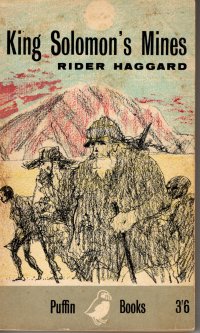 I picked up this book, another Berryville score, simply because it was not a Robert E. Howard or Conan book. I’ve passed over Haggard’s She on a couple of occasions–it’s on the book shelves in the hall, which I have looked through when looking for something to read from time to time, but never seemed the right moment for it. This title, on the other hand, shares the title with one of the two Richard Chamberlain Allan Quatermain movies from the 1980s–which was on Showtime, so I saw it a bunch. So I picked it up first amongst the Haggard books. The two I have. As it turns out, this is the first Quatermain book and the book Haggard published before She, so I accidentally got the order right.
I picked up this book, another Berryville score, simply because it was not a Robert E. Howard or Conan book. I’ve passed over Haggard’s She on a couple of occasions–it’s on the book shelves in the hall, which I have looked through when looking for something to read from time to time, but never seemed the right moment for it. This title, on the other hand, shares the title with one of the two Richard Chamberlain Allan Quatermain movies from the 1980s–which was on Showtime, so I saw it a bunch. So I picked it up first amongst the Haggard books. The two I have. As it turns out, this is the first Quatermain book and the book Haggard published before She, so I accidentally got the order right.
So: A British nobleman and a retired Navy captain engage Allan Quatermain, an old elephant hunter, to take them into uncharted Africa in search of the nobleman’s brother who sought to find the legendary mines of King Solomon. Quatermain comes up with a map from an explorer from several hundred years ago purportedly showing the way, and they take off, doing a little hunting along the way. They encounter difficulties crossing a desert and then the mountains, but they find Wakanda Kukuanaland, a hidden tribe in a fertile valley surrounded by mountains. It is ruled by a brutal warlord who deposed his own brother and who follows the advice of an ancient witch who encourages him to conduct annual purges of tribesmen to keep himself in power. Quatermain and party convince the natives that they’re from the stars, but when the warlord starts to doubt, the group helps the most noble of their porters, Umbopa, the son of the deposed king, to lead a rebellion. After which they are shown the mines by the witch, who dies trying to trap the men in the mines. They escape with but a couple pockets’ full of stones but with their lives, and they find the nobleman’s brother at an oasis on the way back to civilization.
So the film, which I saw over and over, differs greatly from the book as it was recast/recut into an Indiana Jones-style adventure (so common in the 1980s) with a female love interest and whatnot. Still, it made me want to watch the films again.
I was going to call this book a cross between Rudyard Kipling and Edgar Rice Burroughs, but that’s a bit dismissive. The book is credited with being the first of the “lost world” (not “hollow world”) genre, which means it spawned the whole type of adventure story that would influence Robert E. Howard and generations of pulp writers. And Rider Haggard and Rudyard Kipling were life-long friends.
The book might get knocked for its colonialism and portrayal of African natives by facile interpreters hungry for an A or tenure, but it, like so many works, provides a fairly balanced view of Africans as human with a variety of virtues and vices, but that they did not have the Gatling gun and organization that set the West apart at the time. It’s a shame that the work gets dismissed for academic clout and huzzahs. This is a Penguin edition, though, which meant that at least as late as the 1950s it was studied in school.
It reads like a piece of the time; the writing is vivid and has a great deal of depth, but it’s a little slower than pure pulp. Still, it’s not especially archaic, and it should be accessible to any literate person of our time.
So maybe I will get to She sooner rather than later, but I do have a lot of more pulpy works from Berryville which I will likely get to first especially as they have remained together instead of being scattered amongst the Nogglestead stacks.


